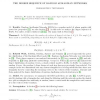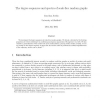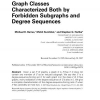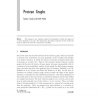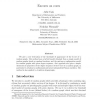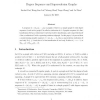105
click to vote
CORR
2011
Springer
14 years 4 months ago
2011
Springer
We analyze the asymptotic behavior of the degree sequence of Random Apollonian Networks [11]. For previous weaker results see [10, 11].
RSA
2006
15 years 13 days ago
2006
We investigate the degree sequences of scale-free random graphs. We obtain a formula for the limiting proportion of vertices with degree d, confirming non-rigorous arguments of Do...
128
click to vote
JGT
2008
15 years 15 days ago
2008
: Given a set F of graphs, a graph G is F-free if G does not contain any member of F as an induced subgraph. We say that F is a degree-sequence-forcing set if, for each graph G in ...
IM
2006
15 years 15 days ago
2006
We propose a new random model of web graphs in which the degree of a vertex depends on its age. We characterize the degree sequence of this model and study its behaviour near the c...
COMBINATORICS
2006
15 years 17 days ago
2006
We give a new derivation of the threshold of appearance of the k-core of a random graph. Our method uses a hybrid model obtained from a simple model of random graphs based on rand...
DM
2008
15 years 18 days ago
2008
A sequence d = (d1, d2,
DAM
2008
15 years 18 days ago
2008
In this paper characterizations of connected unicyclic and bicyclic graphs in terms of the degree sequence, as well as the graphs in these classes minimal with respect to the degr...
CORR
2010
Springer
15 years 19 days ago
2010
Springer
Uniform sampling from graphical realizations of a given degree sequence is a fundamental component in simulation-based measurements of network observables, with applications rangi...
ALGORITHMICA
2007
15 years 20 days ago
2007
Two classic “phase transitions” in discrete mathematics are the emergence of a giant component in a random graph as the density of edges increases, and the transition of a rand...
102
click to vote
SODA
1997
ACM
15 years 1 months ago
1997
ACM
We give a polynomial-time algorithm for the following problem: Given a degree sequence in which each degree is bounded from above by a constant, select, uniformly at random, an un...
